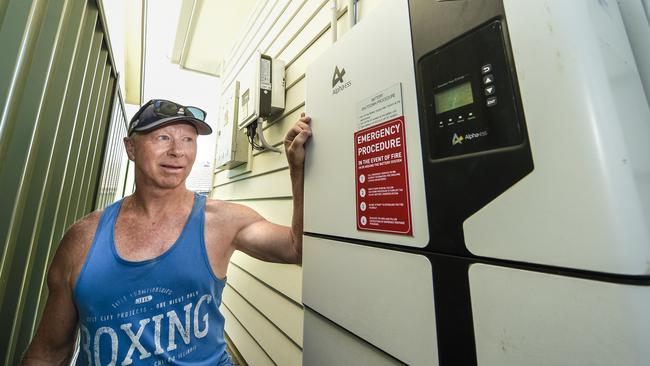Homeowners with virtual power plants are earning money from selling excess energy
When the heat hits, aircon use can send power bills through the roof. But not for these owners of home batteries, who can sell power back to the grid at up to 50 times the standard solar feed-in rate.

SA News
Don't miss out on the headlines from SA News. Followed categories will be added to My News.
- Keep yourself cool and the energy bills down
- Battery scheme reaches 5000, but subsidy won’t remain forever
- Subscriber rewards for this month
As summer temperatures soar and demand ramps up on South Australia’s electricity system, there’s a group of householders keenly watching power prices spike.
Not because they’re worried but because they stand to cash in on their investment in a home battery.
Some have earned more than $7 per kilowatt hour for brief periods selling their power – a far cry from the 38c/kWh to buy energy from the grid or a solar feed-in tariff of 10c to 20c/kWh.
The households are part of the growing number of virtual power plants (VPPs), where they agree to let retailer and energy management companies dip into their battery to supply power to the grid.
There are now eight virtual power plant schemes in SA, each with differing conditions, where a household has solar and battery and the energy management company can aggregate the battery power.
Among them is the ShineHub scheme run in conjunction with retailer Powershop.
“Under normal operations, the solar panels make power during the day, power the house and charge up the battery,” ShineHub chief executive Alex Georgiou said.
“When the battery is full, you send power into the grid and you get the normal solar feed-in tariff.”
The battery supplies the house after the sun goes down.
“But the VPP is tracking the spot price and when it goes above a threshold of $700/MWh we discharge the battery into the grid,” Mr Georgiou said.
From that point, the householder will earn at least 37.9c/kWh.
The rate can rise to $7.05/kWh as it did on December 19 last year when the spot price hit the ceiling of $14,700/MWh from 6:30pm to 7:30pm – earning a householder with a 10kWh battery about $70 for the hour.

ShineHub, which has just signed up its 1000th customer, estimates in an average year its VPP would draw on a battery less than 100 times but earn a householder about $300.
Most other VPP schemes do not directly link to National Electricity Market spot price but offer a range of other incentives.
There are varying feed-in rates and prices for buying from the grid – so overall benefits will depend on individual household usage patterns.
– AGL gives a sign-up bonus and a regular quarterly payment to have access to the battery.
Simply Energy calculates a daily access credit.
– AGL and several other schemes offer a discount on the daily supply charge, which is usually about a $1/day.
– Tesla eliminates the daily fee and discounts its battery and installation.
– Sonnen offers an overall managed power system.
– Sonnen also has partnered with Powerclub, which is developing a scheme linked to wholesale pricing and blockchain technology for greater transparency.
– EnergyAustralia is working with Redback on a VPP.
– Origin Energy has a Victorian VPP project but has yet to establish an SA scheme.
Energy and Mining Minister Dan van Holst Pellekaan said VPPs were turning the energy market on its head, making households into smart generators of electricity and profits.
“South Australians’ massive investment in solar panels combined with falling prices for home batteries and State Government subsidies of up to $6000 have made SA a world leader in VPPs,” Mr van Holst Pellekaan said.

“The transformation of SA’s electricity network will deliver cheaper, more reliable and cleaner electricity to an ever growing number of households.”
More than 5000 homes have had batteries installed or ordered using the government’s subsidy of up to $6000.
Seacliff Park resident and ShineHub customer Peter Dunn got a 10.3kWh battery about two months ago, adding to the 5KW solar array he has had for a year.
“We’ve noticed the difference straight away,” he said.
“Our bills are negative, we’re getting money back.”
Mr Dunn, an MFS firefighter, said the battery got the household through the 6pm-10pm peak after the solar phased down “so we’re not really using anything from the grid”.
The Australian Energy Market Operator projects that rooftop solar and batteries could provide up to a fifth of electricity consumption by 2040, triple the current contribution.
It is currently running trials and consultation on how to integrate the significant input from VPPs into the grid.
It wants VPPs to smooth down the high peaks in price for the benefit of all consumers, without creating risks of destabilising the system through erratic injection of power.
